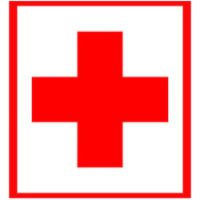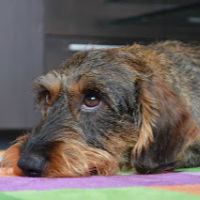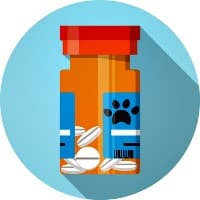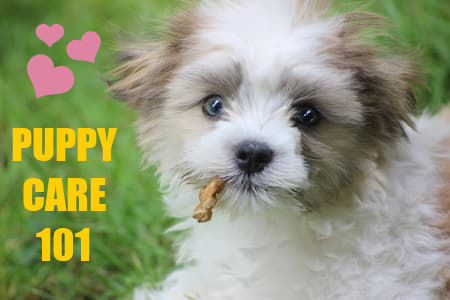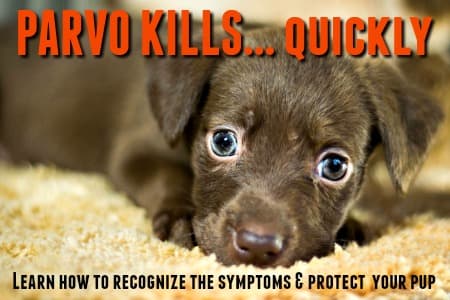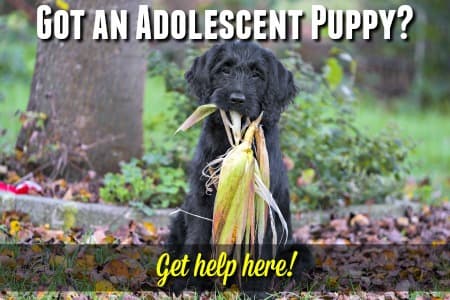FYI: If you buy something through a link on this site I may earn a commission - at NO extra cost to you.
Stuff That's Poisonous to Dogs
Some stuff that's poisonous to dogs is fairly obvious, but there's are also many everyday things that you may have no idea could hurt your dog.
If it was as easy as a bottle labeled 'Poison' it would be much easier to keep your dog safe!
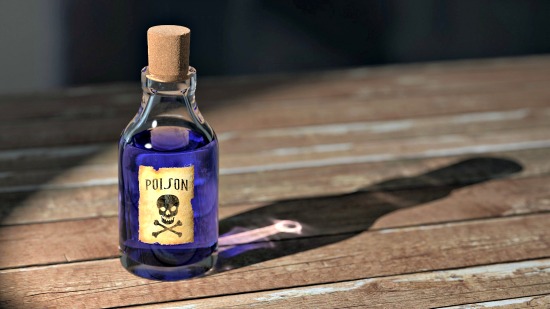
Unexpectedly toxic items which could poison your dog includes common food items, medications and vitamins, flowers and plants, cleaning products and other items that you probably wouldn't think twice about - unless you were aware of their dangers.
Puppies in particular are notorious for getting into things they
shouldn't, and they tend to operate on the assumption that everything is
edible until proven otherwise.
If your little guy thinks it's perfectly okay to eat that cardboard box, he won't think twice about snacking on anything that you leave lying around!
So, keep Fido safe by making sure he never gets a chance to eat (or drink) any of the dog poisonous items on this page.
Use these on-page links to jump directly to the category you're most interested in or simply scroll through to see the full article.
Foods Poisonous to Dogs
Dogs can sometimes act as though they're four-legged trash cans, happy to eat leftovers, scraps, tidbits and anything anyone cares to toss their way.
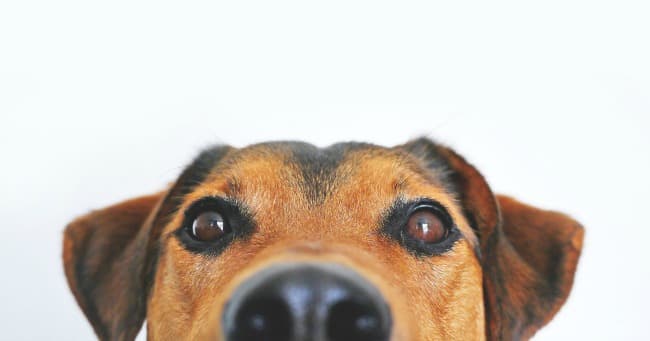
Unfortunately for Fido he doesn't know that some foods that his human family enjoys are toxic to him. Even more dangerous is that many times we humans are also totally unaware of the doggie danger lurking on our plates or in our pockets.
Apples (including Crabapples)
Although the regular flesh of apples isn't considered dangerous, the leaves/stems/pips or seeds of apples and apple trees are all toxic to dogs.
When ingested chemicals in them are converted to Cyanide, a very dangerous poison.
In Fall, the chemicals in the leaves/stems/seeds is in it's most concentrated form, making fallen leaves even more deadly.
Symptoms of poisoning from apples/crabapples can include:
- Panting
- Difficulty breathing
- Red gums, tongue, lips
- Dilated pupils
Avocados
Avocados contain a toxin called Persin which can cause:
- Vomiting
- Diarrhea
- Intestinal problems
The Avocado pits are also a danger in terms of:
- Choking
- Intestinal or bowel obstruction
Candy & Gum
Candy that contain the sweetener Xylitol which can cause:
- Sudden drop in blood pressure
- Seizures
- Liver failure
Hard candies of all sorts are the ones most likely to contain Xylitol, but other candies and gum (even sugarless gum) can also have Xylitol as an ingredient.
*Xylitol may be listed in the ingredients as Birch Sugar, so beware!
Chocolate
Chocolate contains large amounts of natural stimulants called Methylxantines.
The darker the chocolate the higher the concentration of these compounds and the more danger to your dog.
Even white chocolate can cause problems.
Cocoa powder has similar dangers and cocoa beans are extremely toxic.
Symptoms of chocolate poisoning in dogs include:
- Nervousness
- Extreme panting
- Seizures
- Death
It's important to be especially careful during holidays such as Easter, Halloween and Christmas, when lots of chocolate and candy is in your home.
You can learn more about what happens when a dog eats chocolate and what to do to keep him safe on my Help - My Dog Ate Chocolate! page.
Citrus Fruit
The peel, pith and seeds of citrus fruits (oranges, lemons, limes.) can cause irritation to your dog's digestive system, especially if eaten in large quantities.
Grapefruit has the potential to actually be toxic to your dog.
The peel, pith and seeds of grapefruit are the most dangerous as they contain chemical compounds which can cause:
- Lethargy
- Depression
- Diarrhea
- Vomiting
- Photo-sensitivity (light sensitivity)
- Drooling
- Trembling
- Death
If your dog ingests grapefruit have him examined by a veterinarian right away so that you can make sure that he is safe.
Grapes & Raisins
These can be dangerous to your dog and cause a bad reaction if ingested.
Symptoms of toxicity can include:
- Fatigue
- Vomiting
- Diarrhea
- Renal (kidney) failure
Mushrooms
Mushrooms can be poisonous to dogs.
Mushrooms contain toxic compounds which can cause serious problems such as:
- Liver damage
- Kidney damage
- Convulsions
- Coma
- Death
Macadamia Nuts
Macadamia nuts are surprisingly toxic to dogs.
They can cause temporarily paralysis - which is obviously very dangerous.
Moldy Food
Food which has turned moldy or rotten is toxic and dangerous for dogs, just as it is for humans and other animals.
It is NOT safe to feed dogs food which has 'gone off' or is moldy/turning bad.
The fungi in mold cause a specific type of food poisoning called Mycotoxicosis which can cause serious, and potentially deadly, symptoms including:
- Panting
- Shaking
- Hyperactivity
- Increased heart rate
- Fever
- Loss of co-ordination
- Seizures
- Vomiting
Onions & Garlic
Onions and garlic contain a toxin called Thiosulphate.
Symptoms of dog poisoning from onions or garlic usually begin as:
- Digestive system upset (diarrhea and/or vomiting)
- General fatigue and weakness
Thiosulphate affects the red blood cells in your pup's body.
Within a few days symptoms could progress to include:
- Bloody diarrhea
- Difficulty breathing
- Death
Garlic is more dangerous than onions, approximately 3 - 6 times more dangerous.
Toxicity levels for onions is 0.5% of a dogs body-weight, or approx 15/30mg per kg of body weight. For garlic it is 5mg per kg of body-weight.
In general it's best to just avoid giving you dog ANY amount of onions or garlic.
Peanut Butter
Yes, you read that right... peanut butter!
BUT not all peanut butter, just some of them.
This is a new development because recently SOME manufacturers have started adding Xylitol (see above) to their recipes.
So, always check the ingredient list on your jar of peanut butter closely if your pet is going to be sharing your peanut butter.
Recently, Xylitol is being shown on ingredient labels as 'Birch Sugar'... regardless of it's name, it's the same, highly toxic product.
Uncooked Yeast Dough
This may sound like an odd addition to a dog poisonous food list, but it's really pretty obvious once you think about it.
If uncooked dough expands inside your pups tummy it can cause internal damage.
Less obvious is the fact that as the dough rises it can form alcohol and result in
alcohol poisoning (see symptoms above)
Alcohol
Dogs should never drink alcohol, not even a sip of beer!
Depending on the amount of alcohol ingested it can cause:
- Vomiting
- Diarrhea
- Difficulty breathing
- Coma
- Death
Hops (which are in beer) can cause:
- Increased heart rate
- Panting
- Seizures
- Death
Iron Tablets, Vitamins, Medications
Iron tablets, and vitamins which include Iron (including pre-natal vitamins) can cause serious problems for dogs, potentially even fatal ones.
Initial signs of toxicity include:
- Vomiting
- Diarrhea
Although symptoms may seem to improve, within 12 to 24 hours your dog could relapse and experience:
- Shock (signs incl. weakness, lethargy, low BP, difficulty breathing)
- Depression
- Seizures
- Liver damage
- Kidney failure
Other common people medications and medical preparations can be poisonous to dogs.
Oral medications toxic to dogs include:
- Pain killers such as Ibuprofen and Aleve (Naproxen)
- 'PM' formulas of medications
- Adderall
- Cold medications
- Cough medicines
- Anti-depressants
- Sedatives
- Anti-cancer drugs
- Diet pills
- Decongestants
Topical creams and ointments, nasal sprays, certain eye-drops and so on are also potentially poisonous to dogs.
Nicotine
Cigarettes, E-cigarettes, nicotine patches and nicotine gum are all highly toxic to dogs and can kill Fido very quickly.
Symptoms (or even death) can occur in as little as one hour!
Signs of nicotine poisoning include:
- Vomiting
- Diarrhea
- Abnormal heart rate (high)
- Drooling
- Trembling
- Lethargy
- Muscle weakness
- Shallow or slow breathing
- Collapse
- Death
If treated quickly a dog can often be saved or the damage reversed, but there is NO TIME to wait and see.
If you think Fido may have ingested nicotine in ANY form, get him to your vet or an emergency vet immediately.
Household Products Poisonous to Dogs
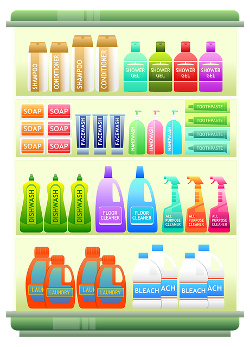
Most homes are filled with a host of chemical-based products which can be toxic to our dogs if ingested.
It could be something as obvious as an insecticide or pesticide, or as seemingly innocuous as laundry detergent or fabric softener sheets.
To make matters worse, many cleaning stuffs are kept in low cupboards, garages, back yards and other places where it's fairly easy for Fido to get to them.
Making sure to correct this is an important part of puppy proofing your home and keeping your dog safe.
Cleaning Products
The average home contains a variety of different cleaning products, some of which can cause real problems if ingested by your puppy or dog.
If your dog eats/licks up any of the following products it's important to call a Poison Hotline (click here for number) or a veterinarian IMMEDIATELY (call a 24 hour pet hospital if it's after hours) and follow their advice.
- Bleach (and any products containing bleach)
- Floor cleaners (incl. Mr Clean and PineSol)
- Drain cleaners/de-cloggers
- Toilet cleaners (tablets and liquid)
- Bathroom cleaners (incl. Scrubbing Bubbles)
- Lime/rust removal products
- Oven cleaners
- Laundry detergents and dryer sheets
- Dishwasher tablets or powder
The symptoms your dog might experience from poisoning by these types of products vary depending upon the individual chemicals they contain.
Symptoms of dog poisoning MAY include:
- Vomiting
- Diarrhea
- Excessive drooling
- Ulceration of mucus membranes/esophagus/gut
- Internal bleeding
- Kidney failure
- Intestinal blockage
- Seizures
- Collapse
- Death
Outdoor Treatments/Products
Chemicals used for swimming pools, lawn and plant care, pest control and automotive repair or maintenance products are all extremely dangerous and poisonous to dogs.
These include:
- Rat/mouse poison or bait
- Insect poison or bait (ants/slugs/flies/cockroaches)
- Insect repellant
- Fertilizers and weed control products
- Plant food
- Chlorine and other pool chemicals/tablets
- Anti-freeze, coolant, car cleaning products
- De-icer for cars and pathways
- Cocoa mulch
Other Stuff Poisonous to Dogs
Then there are the random everyday items that can harm our dogs.
These include:
- Batteries (extremely corrosive and dangerous)
- Lead paint (older homes/toys/furniture can still contain this)
- Heavy metals in coins and other metal items
- Flea and tick medications (when not given/applied properly)
Please do NOT take a 'wait-and-see' approach if you even THINK your dog has ingested a dangerous item or substance. Get vet help immediately.
Symptoms may not show up right away and if you wait it could cost your dog his life.
Plants Which Are Poisonous to Dogs
Many plants are toxic to dogs, effects can range from mild topical irritation to skin and/or mucus membranes (mouth, tongue, eyes etc.) to serious, potentially deadly, reactions.
Just one, or multiple, parts of a plant or tree can be dangerous, including bulbs, flowers, seeds, bark, stems and more.
Plants which can cause serious injury or even be fatal if ingested by your dog include:
- Azalea
- Checkered Lily
- Chinese Lantern
- Climbing Lily
- Cuban Lily
- Deadly Nightshade
- English Laurel
- Foxglove
- Heather
- Heliotrope
- Larkspur
- Morning Glory
- Wood Nightshade
Plants which can cause vomiting & diarrhea in dogs include:
- African Boxwood
- Bird of Paradise
- Buckeye
- Burning Bush
- Columbine
- Holly
- Juniper
- Myrtle
- Pansy
- Scotch Broom
- Snowberry
- Sweet Pea
- Wisteria
Some trees/bushes (and their berries/fruit, or part of it) are poisonous to dogs. The most dangerous include:
- Apple (seeds)
- Apricot (seeds, leaves, stems)
- Black Cherry (seeds, leaves, stems)
- Black Locust (bark, leaves, seeds)
- Carolina Laurel Cherry (leaves, branches)
- Cherry (leaves, stems, seeds)
- English Laurel (seeds)
- English Yew (bark, leaves, seeds)
- European Mistletoe (entire plant)
- Japanese Yew (bark, leaves, seeds)
- Jerusalem Cherry (bark, leaves, seeds)
- Peach (seeds, leaves, stems)
The ASPCA website has a very comprehensive list of plants which are toxic to dogs (you can also search for those toxic to cats or horses). It's worth bookmarking so you can find it easily if you need to.
Dog Poisoning Protocol
With a lot of the above poisonous foods and toxins it doesn't take very much to make your dog seriously ill.
ALWAYS, ALWAYS SEEK VETERINARY ADVICE if you even just think your puppy or dog has ingested dangerous or poisonous foods. Every minute counts in these situations!
If your pet has only ingested a small amount of one of these poisonous foods and is experiencing some vomiting, diarrhea or other fairly mild symptoms, you may be inclined to think that everything is okay.
BUT you should always get veterinary help, or check with your local poison control center, because the real damage may not show up right away.
In some cases symptoms gradually worsen over a period of hours, or even days, and if you 'wait and see' it could be too late for your precious puppy by the time you seek help.
The ASPCA Animal Poison Control Center number...
1-888-426-4435 or 1-800-548-2423
(There may be a $65 charge for this service)
The ASPCA has a mobile app which can help keep your pet safe no matter where you are. Check it out here... ASPCA Animal Poison Control Center App
Being prepared can make all the difference in an emergency situation.
I'd also suggest visiting my Dog Poisoning page to learn more about common household items that are toxic to dogs, and what to do if you suspect Fido has ingested something dangerous.
you might also like...
The Digital Clinic for Pets
FTC Disclosure: Some pages on this site contain affiliate links. I may earn on qualified purchases.
